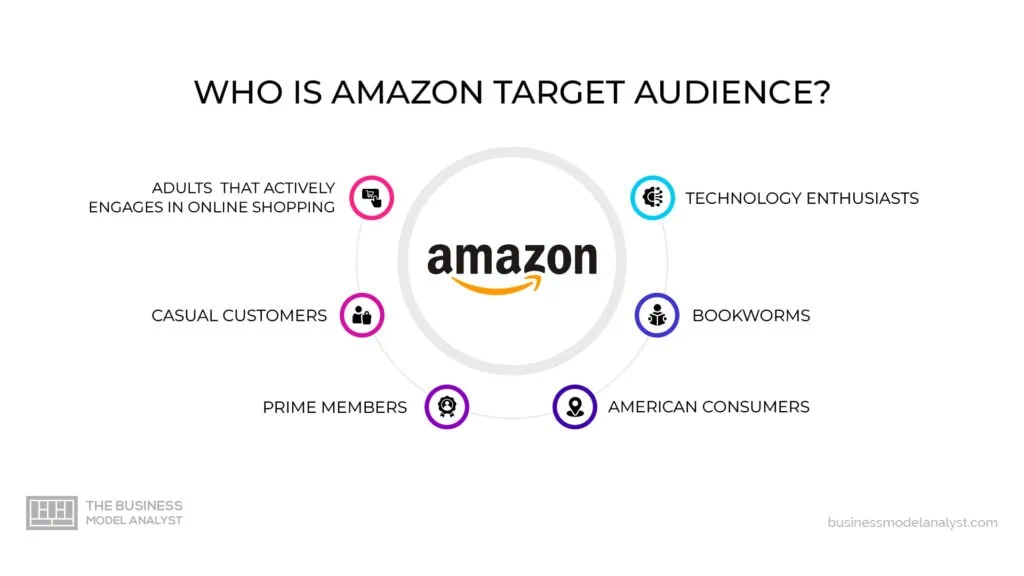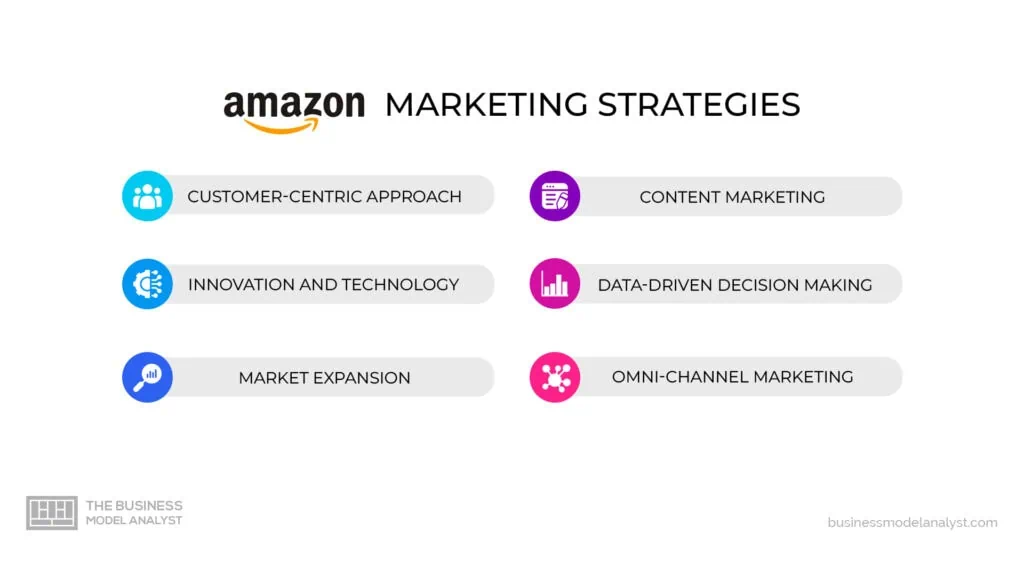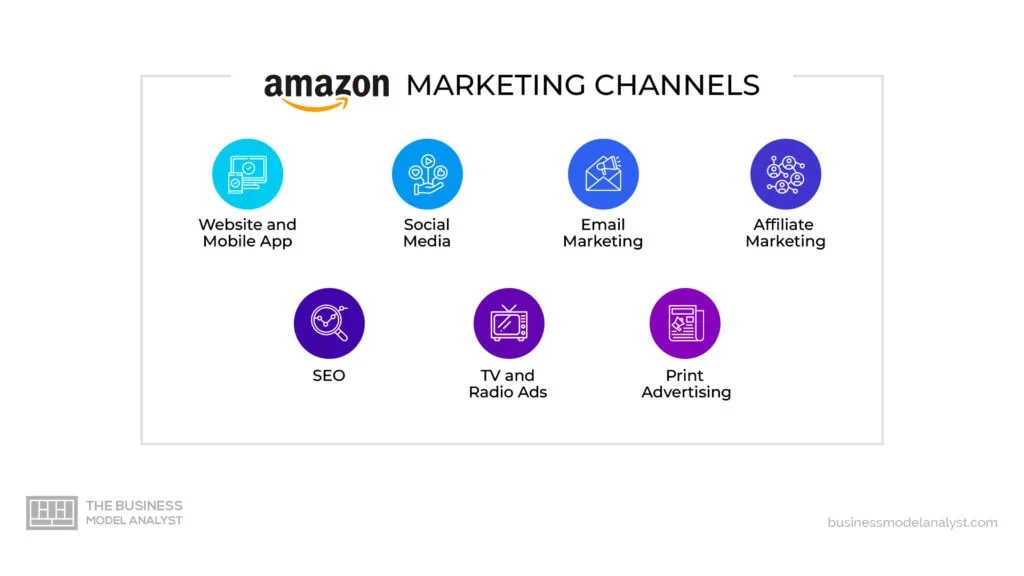Amazon Marketing Strategy: Case Study
The Amazon Marketing Strategy has been largely responsible for the company’s meteoric rise to becoming one of the most powerful players in the global market. Dissimilar to conventional marketing approaches, Amazon’s strategy has revolutionized the way businesses operate, reach out to customers, and leave a lasting impact on their shelves, both virtual and physical.
This article will explore Amazon’s marketing goals and objectives, target audience, marketing mix, key strategies, marketing channels, and provide insights on how to apply Amazon marketing strategy to your own business.
By understanding and leveraging Amazon’s strategies, brands can enhance their own marketing efforts and achieve significant growth.
Contents
Amazon Marketing Goals and Objectives
Amazon’s marketing strategy aims to create a seamless shopping experience, increase customer loyalty, and expand its market share. It revolves around customer satisfaction through data-driven decision-making. This approach has helped Amazon maintain a competitive edge and achieve sustained growth. The primary goals and objectives of Amazon’s marketing strategy include:
- Customer Satisfaction: Ensuring a high level of customer satisfaction through excellent service and a user-friendly shopping experience.
- Market Expansion: Continuously expanding its market presence by entering new regions and launching new product categories.
- Brand Loyalty: Building and maintaining strong brand loyalty through programs like Amazon Prime, which offers exclusive benefits and faster shipping.
- Innovation: Investing in innovative technologies to improve operations and enhance the customer experience.
Who is Amazon Target Audience?

Amazon’s target audience encompasses a wide range of individuals, reflecting the company’s broad appeal and diverse customer base. To effectively understand who Amazon’s customers are, it’s essential to analyze their customer segmentation from various perspectives: demographic, geographic, behavioral, and psychographic aspects.
Examining the demographic segmentation, Amazon primarily targets adults aged 18 to 60, with a significant proportion falling within the 35-49-year-old age bracket. This age group represents a critical segment that actively engages in online shopping and has the financial means to purchase products from Amazon. In addition, this demographic represents a sizable market segment that is likely to have access to technology and is already accustomed to online shopping practices.
When exploring Amazon’s geographic target audience, it becomes evident that the company’s vast customer base primarily comes from the United States. More than 60% of Amazon’s website traffic is from the US alone. This highlights the dominance of Amazon in the American market and its efforts to capture a significant share of the e-commerce sector within the country.
From a behavioral standpoint, Amazon’s customer segmentation sets apart casual customers (non-Prime) from those with a Prime membership. The behavior of these two groups differs significantly in terms of purchasing frequency. While 37% of casual customers make multiple purchases throughout the year, those with a Prime membership go a step further. Nearly half of Prime members make at least one purchase every week, and a compelling 74% purchase monthly. This data highlights the appeal and loyalty that Amazon Prime membership generates, often leading to increased engagement and frequency of purchases.
Psychographic segmentation also plays a vital role in understanding Amazon’s target audience. Widespread customer surveys, analysis of purchase patterns, and engagement data have provided insights into the preferences, hobbies, and interests of Amazon customers. Amazon caters to various psychographic segments such as technology enthusiasts, bookworms, fitness enthusiasts, home improvement enthusiasts, fashion-forward individuals, and many more. By identifying and catering to the psychographic needs and preferences of its customers, Amazon can successfully offer tailored shopping experiences and personalized product recommendations.
To illustrate how Amazon efficiently reaches and entices its target audience, consider several examples. Firstly, by targeting adults between the ages of 18 and 60, Amazon acknowledges that this demographic constitutes a significant proportion of online shoppers, possesses purchasing power, and uses technology consistently. Consequently, Amazon tailors its marketing strategies and initiatives to effectively reach this age group through various digital channels such as social media, email marketing, search engine optimization, and targeted online advertising.
Furthermore, with a predominant customer base in the United States, Amazon directs many of its marketing efforts toward reaching American consumers. The company invests in national campaigns, partnerships with popular institutions, sponsorship of major events, and targeted advertising on regional platforms. Additionally, Amazon positions its warehouses strategically throughout the country to offer prompt shipping and delivery services, ensuring it caters efficiently to the needs and preferences of American customers.
Amazon’s segmentation by behavioral aspects enables the company to personalize its marketing efforts. By focusing on emphasizing the benefits of Prime membership such as faster shipping, exclusive discounts, and access to various services like Prime Video and Prime Music, Amazon can ignite loyalty and encourage their development as loyal, returning customers. This approach fosters greater trust and familiarity between Amazon and its customers, upholding the formation of a dedicated consumer base.
Moreover, the utilization of various psychographic segments offers Amazon the opportunity to resonate with a broad range of customer types. By carefully curating product suggestions, recommending items related to specific hobbies or interests, and providing customization options, Amazon leverages intricate algorithms to captivate its customers. Catering to different personalities, aspirations, and financial statuses speaks volumes about Amazon’s adaptable marketing strategies, solidifying its reputation as an e-commerce giant capable of satisfying everyone’s preferences and needs.
Marketing Mix of Amazon
Amazon’s marketing mix, also known as the 4Ps, involves various strategies that align with its extensive range of products. This mix includes the product offerings, place or distribution channels, promotional activities, and pricing strategies employed by the company.
Product
Amazon’s product mix is undeniably vast. The company initially started as an online bookstore and gradually expanded into an online retail giant. Besides retail goods and services, the company has diversified its product line to include various products. One such product is Amazon Prime, which provides subscribers with free shipping, and access to Prime Video, Prime Music, and more.
In addition, Amazon has ventured into consumer electronics, such as e-readers, smart speakers, and streaming devices. The Kindle e-reader, Echo smart speakers, and Fire TV have gained significant popularity.
Another crucial part of Amazon’s product mix includes digital content distribution services. It offers various e-books, music, movies, and TV shows through its digital platforms like Kindle Store, Amazon Music, and Amazon Video.
Amazon’s product mix also includes Amazon Web Services (AWS), a cloud computing platform. AWS offers a range of services such as storage, computing power, server hosting, database management, and more. This has allowed Amazon to tap into the business-to-business (B2B) market successfully.
Amazon Publishing, another part of its product mix, allows authors to self-publish and sell their books through the Kindle Direct Publishing platform. This has revolutionized the publishing industry, empowering aspiring authors to reach a wide audience with ease.
Amazon has also expanded into physical retail with the acquisition of Whole Foods Market. This move provided Amazon with brick-and-mortar retail stores, allowing customers to make purchases offline as well.
Pricing
Amazon adopts various pricing strategies as part of its overall marketing mix. One of their key strategies is a market-oriented pricing approach. By considering the price competitiveness of their products alongside rival offerings, Amazon strives to offer products at competitive price points, often ensuring that customers receive good value for their money.
Additionally, Amazon employs a differential pricing strategy. It offers different pricing tiers for its services, targeting different customer segments. For instance, Amazon Prime offers multiple subscription options, catering to customer preferences based on the frequency of usage.
Amazon also employs a freemium pricing strategy for several of its products and services. By offering a baseline service for free, they entice customers to upgrade to paid versions. The AWS free tier is a prime example.
Lastly, Amazon utilizes a pay-as-you-go pricing strategy for its cloud services, AWS. Rather than requiring an upfront payment or subscription, customers are charged for the actual usage of the service. This allows businesses to have flexibility and scalability for their computing needs.
Place
Amazon’s distribution channels include its online platform, physical stores like Amazon Go, and partnerships with third-party sellers.
Amazon’s official e-commerce platforms, websites, and apps serve as the primary distribution channels for its products. Customers can access Amazon’s wide range of offerings from anywhere in the world through its user-friendly websites or mobile apps. The company leverages a robust logistics network, including fulfillment centers and last-mile delivery services, to ensure fast and reliable shipping.
Also, with its physical stores like Amazon Go and Whole Foods Market, Amazon has brick-and-mortar stores in its distribution channels. This allows customers to physically visit their supermarkets and experience the convenience of shopping at both traditional retail stores and online.
Amazon’s strategic use of various distribution channels allows it to reach a wide audience and provide a seamless shopping experience, regardless of the customer’s location.
Promotion
Advertisement plays a significant role in Amazon’s promotional mix. Through its extensive online and offline advertising campaigns, Amazon reaches millions of potential customers worldwide. With an ample marketing budget, Amazon utilizes various channels such as TV, radio, print media, digital ads, and sponsored advertisements on social media platforms.
Sales promotions are another component of Amazon’s promotional mix. Special deals like “Deals of the Day” and “Lightning Deals” encourage customers to make purchases by offering time-limited discounts. In addition, Amazon conducts seasonal sales like “Prime Day” and “Black Friday” that boost sales significantly.
Public relations activities, such as strategic partnerships and collaborations, help Amazon maintain a positive brand image. Launching new services with the involvement of well-known companies or educational institutions garners attention and credibility.
While Amazon excels in digital marketing, it also utilizes direct marketing initiatives. For instance, customers receive personalized emails based on their browsing behavior, which highlights products they may be interested in. Direct communication via mail and text messages also keeps customers informed about upcoming sales and promotions.
What are Amazon Marketing Strategies?

Customer-Centric Approach
Amazon’s customer-centric approach is one of the core pillars of its marketing strategy. It encompasses a wide range of tactics and initiatives that are all aimed at enhancing the shopping experience for their customers. By putting the needs and desires of their customers at the forefront, Amazon has been extremely successful in building strong relationships and driving repeat business.
One of the key aspects of Amazon’s customer-centric approach is its personalized recommendation system. By analyzing customer behavior and purchase history, Amazon is able to offer highly targeted recommendations that are tailored to individual preferences. For example, when a customer purchases a book, Amazon’s algorithm can suggest similar books that the customer may find interesting. This not only enhances the overall shopping experience but also increases cross-selling opportunities.
Consider the “Customers who bought this also bought” feature on Amazon product pages. When a customer views a specific product, Amazon displays a list of other products that customers who have bought the same item often purchased. This serves as an effective cross-selling tactic as it exposes customers to related products they may be interested in, thus encouraging additional purchases.
To further reinforce their customer-centric approach, Amazon ensures a hassle-free returns process. They understand that customer satisfaction goes beyond the purchasing experience and extends even after the product has been received. Amazon’s generous return policy allows customers to easily return items they are unsatisfied with or received incorrectly. The ease and convenience of their return process earn customer trust and loyalty. This positive experience not only promotes customer satisfaction but also assists in building long-term relationships with their customers.
Another significant element of Amazon’s customer-centric approach lies in its exceptional customer service. Maintaining prompt and efficient customer support is crucial for any business, and Amazon recognizes this. They have invested heavily in establishing excellent customer service channels to address any concerns or issues customers may have. Whether it is through phone support, email communications, or their live chat feature, Amazon ensures their customers receive timely assistance for a positive shopping experience.
One of the reasons Amazon values customer loyalty and retention is the profitability it brings. Research reveals that acquiring a new customer can cost five times as much as retaining existing customers. By prioritizing their customers and focusing on building strong relationships, Amazon increases the chances of repeat business and reduces customer churn. When customers have positive experiences, not only are they more likely to continue shopping on Amazon but they are also more inclined to recommend the platform to others.
Innovation and Technology
Amazon’s commitment to innovation and technology is one of the primary factors that sets it apart in the e-commerce industry. The company consistently invests in advanced technologies to deliver excellent customer experiences, streamline operations, and maintain its position as a global market leader. With a customer-centric approach, Amazon focuses on developing disruptive technologies that revolutionize not only its internal processes but also the way customers interact with the brand.
One of the most notable examples of Amazon’s innovation and technology is its voice-controlled virtual assistant, Alexa. Introduced with the Amazon Echo smart speaker, Alexa has become an integral part of many households worldwide. With Alexa, customers can simply use their voice to interact with Amazon, including purchasing products, managing their shopping lists, and even controlling various compatible smart home devices. This advancement has made online shopping more intuitive and convenient, offering a seamless experience where customers can just ask Alexa to order products without browsing through a website or mobile app.
Amazon also leverages artificial intelligence (AI) and machine learning (ML) algorithms to optimize its operations and enhance the overall customer experience. Through AI-powered algorithms, Amazon constantly analyzes customer behavior, purchase patterns, and preference data to generate personalized product recommendations. By tailoring product selection for each customer, Amazon creates a more personalized shopping experience, boosting customer satisfaction and driving loyalty.
In addition, Amazon’s inventory management systems utilize AI and ML to predict customer demand and automate stock replenishment processes. With advanced algorithms, the company can optimize inventory levels, reducing overstock and ensuring products are available when customers need them. This not only improves efficiency and reduces carrying costs but also decreases instances of stockouts and disappointed customers. By harnessing the power of AI, Amazon commits to consistently delivering on its promise of fast and reliable product delivery.
Amazon Go stores are another groundbreaking innovation from the company. These stores utilize an array of technologies to offer customers a cashier-less shopping experience. Automated cameras, sensors, and computer vision technology enable customers to simply pick up items they need while Amazon’s retail platform tracks the products they select. Upon leaving the store, customers are automatically charged for their purchases through their Amazon accounts. The Amazon Go concept prioritizes speed and convenience, as customers can seamlessly shop without the need for traditional checkouts and cashier lines.
Moreover, Amazon persists in improving its logistics capabilities through innovative technologies. The company has experimented with delivery drones to expedite the shipping process, especially for lightweight, small packages. Amazon believes that utilizing unmanned aerial vehicles will ultimately decrease delivery time and enhance efficiency, although regulatory challenges are slowing down widespread adoption. Nevertheless, it exemplifies Amazon’s quest for cutting-edge solutions to improve logistics performance and exceed customer expectations.
Market Expansion
Amazon continuously seeks opportunities to expand its market presence by entering new regions and launching new product categories. This approach allows Amazon to diversify its offerings, capture a larger share of the market, and ultimately drive growth.
A prime example of Amazon’s market expansion strategy is the acquisition of Whole Foods in 2017. With this strategic move, Amazon not only established its foothold in the brick-and-mortar retail space but also sought to integrate online and offline retail. The acquisition provided Amazon with instant access to a well-established customer base, a nationwide network of physical stores, and recognized brand equity. By combining its e-commerce capabilities with Whole Foods’ physical presence, Amazon expanded its reach and further solidified its position as a leading retailer globally.
Amazon’s entry into emerging markets also plays a significant role in its market expansion strategy. For instance, the company made a strategic attempt to acquire the Indian local e-commerce giant Flipkart in 2018 (Flipkart rejected the deal however, and sold to Walmart). In addition, Amazon actively partners with local businesses and sellers in various countries to boost its presence and offer localized products and services. This approach not only allows the company to cater to specific regional needs but also helps it navigate regulatory requirements and establish strong relationships with local communities.
Amazon’s market expansion strategy also involves continuously expanding its product category offerings. While initially starting as an online bookstore, the company gradually expanded its range to include electronics, household goods, apparel, and much more. By diversifying its product offerings, Amazon appeals to a broader range of customers and attracts new customer segments. For example, the launch of Amazon Devices, including the highly popular Kindle e-readers and Fire tablets, not only serves as a source of revenue but also ties customers more closely to the Amazon ecosystem.
In addition to acquiring existing businesses and broadening its product categories, Amazon actively experiments with innovative business ventures and digital services. One notable example is the Amazon Prime membership program. Through this initiative, Amazon provides fast and free shipping, access to exclusive content and deals, and perks like Prime Video and Prime Music. By creating a loyal customer base through the Prime program, Amazon unlocks various avenues for cross-selling and upselling. For instance, Prime members are more likely to purchase Amazon Echo devices, emphasizing the strategy of integrating hardware and software within the Amazon ecosystem.
Content Marketing
Content marketing allows Amazon to effectively engage with its customers and build trust. By leveraging content marketing initiatives such as Amazon Originals and user-generated reviews, Amazon has been able to create a deep connection with its audience and establish itself as a reliable source of products and information.
One of the prominent content marketing initiatives by Amazon is Amazon Originals, which includes a vast array of exclusive TV shows and movies available for streaming through its Prime Video service. By releasing high-quality, original content, Amazon aims to attract and retain subscribers to its Prime membership program. The compelling and diverse selection of Amazon Originals not only keeps consumers engaged but also differentiates Amazon’s Prime Video platform from its competitors such as Netflix and Hulu. The ability to produce and distribute exclusive content has also allowed Amazon to tap into the growing trend of “binge-watching,” further strengthening its position as a major player in the streaming entertainment industry.
Amazon’s unique content marketing emphasizes user-generated reviews, creating a community where customers freely leave reviews and ratings. These reviews provide valuable insights, helping prospective buyers make informed decisions. This transparency builds trust, as customers trust fellow consumers’ opinions more than advertisements or brand-provided descriptions. By facilitating an honest platform for sharing thoughts, Amazon has become a go-to destination for impartial product reviews, enhancing its reputation as a trusted online marketplace.
Moreover, Amazon utilizes content marketing as a means to attract and support content creators through services like Kindle Direct Publishing (KDP). KDP empowers aspiring authors and publishers to self-publish their books and reach a wide audience of Kindle e-book readers. This author-friendly platform enables independent authors to turn their passion into published works accessible to millions of Amazon users.
By facilitating self-publishing and favoring e-books through its dedicated e-reader devices, Amazon has revolutionized the publishing industry and transformed the way writers distribute their work. The vast selection of books made available by KDP not only enhances the value proposition of Amazon’s Kindle devices but also augments its content ecosystem, strengthening customer loyalty.
By investing in content marketing initiatives like Amazon Originals, user-generated reviews, and convenience for content creators through services like KDP, Amazon consistently strives to enhance engagement, trust, and loyalty from its customer base. Content marketing has proven to be a powerful tool in driving traffic to Amazon’s platform and creating a sense of exclusivity and authenticity around the brand.
An example illustrating Amazon’s successful content marketing strategy is the hit TV series “The Marvelous Mrs. Maisel.” Produced and released as an Amazon Original, this critically acclaimed show has won multiple awards and garnered a vast fanbase. The growing popularity of “The Marvelous Mrs. Maisel” has not only attracted more subscribers to Amazon Prime Video but has also defined the streaming service as a provider of high-quality original content. By investing in such a groundbreaking series, Amazon has utilized content marketing to catapult itself into the homes and hearts of millions of viewers worldwide.
Another example showcasing Amazon’s astute utilization of user-generated reviews can be observed in its customer review system for products. Amazon prioritizes transparency in customer experiences and feedback, providing shoppers with valuable insights needed to make confident purchasing decisions. The inclusion of detailed reviews, along with ratings, enables customers to evaluate products from the perspective of those who have already tested them. This commitment to engaging its customer base through user reviews has resulted in Amazon becoming a trusted online marketplace and contributed to its domination in e-commerce.
On the content creator front, a notable example is Kindle Direct Publishing. Talented authors who self-publish their works using KDP are given an opportunity to gain exposure and connect with countless readers via Amazon’s extensive digital platform. This democratization of publishing revolutionized the traditional industry, allowing authors who were once passed over by traditional publishers to independently distribute their books. By offering a convenient and reader-friendly platform, Amazon empowers content creators, both large and small, inspiring them to produce and distribute their works to a global audience with ease.
Data-Driven Decision Making
One of the key ways in which Amazon utilizes data-driven decision-making is through personalized recommendations. Using advanced algorithms and customer browsing history, Amazon is able to recommend relevant products to each user. These recommendations are often based on previous purchases, viewed items, or items added to the user’s wishlist. By using data analysis, Amazon can offer personalized and dynamic recommendations, increasing the chances of conversion and delivering a personalized shopping experience to each customer.
Another data-driven decision-making strategy Amazon employs is predictive analytics. By analyzing past purchasing behavior and other customer data, Amazon can make accurate predictions about future buying patterns and trends. This helps them anticipate customer demands and optimize their marketing strategies accordingly. For instance, if Amazon sees that there is a notable increase in the sale of a particular product category during a specific season, they can ramp up their marketing efforts for these products, ensuring they are well-stocked and prominently promoted during that period.
In addition, Amazon leverages data-driven decision-making to optimize its advertising strategy. As part of its journey to diversify revenue streams, Amazon launched its advertising platform, Amazon Ads. The platform allows businesses to advertise their products on Amazon’s site. By analyzing customer behavior, search patterns, and purchase history, Amazon provides highly targeted and relevant advertising options for businesses. This not only increases the chances of successful product placements but also maximizes the ROI for advertisers.
Omni-Channel Marketing
Amazon’s omnichannel marketing strategy is an important aspect of its overall marketing approach, aimed at providing a consistent and seamless shopping experience for customers. By focusing on omni-channel marketing, Amazon strives to ensure that customers can enjoy a comprehensive and integrated experience regardless of their preferred shopping channel, whether it’s online, in physical stores, or through mobile apps.
One key advantage of Amazon’s omni-channel marketing strategy is the ability for customers to access and make purchases from the platform in a variety of ways. Whether customers are searching for products on Amazon’s website, using the mobile app to browse, or even visiting a physical store, the company strives to enable customers to connect with the brand and make purchases seamlessly. This omni-channel approach eliminates the need for customers to be tied to a specific channel, giving them the freedom to choose how they interact with and shop from Amazon.
To create this seamless experience, Amazon integrates various channels, ensuring that customer interactions are consistent and synchronized. For example, Amazon utilizes a unified customer account system, which enables users to access their account, shopping cart, and payment methods across multiple devices. This means that customers can start shopping on their laptops and resume their browsing and purchasing activities seamlessly on their mobile devices, all within the same organizational framework offered by Amazon.
Another element of Amazon’s omni-channel strategy is its integration of physical stores into the overall shopping experience. Despite being primarily an online retailer, Amazon has expanded into brick-and-mortar retail with physical stores. These stores not only serve as additional touchpoints for customers to experience Amazon’s products but also provide opportunities for seamless integration between online and offline shopping.
Amazon also understands the significance of mobile commerce and has leveraged this understanding to enhance its omni-channel strategy. Apart from the native shopping app, Amazon has optimized its website for mobile devices, offering a mobile-friendly interface, fast-loading pages, and intuitive navigation. This ensures that customers can easily access and navigate Amazon via their smartphones and tablets, adding to the overall convenience and accessibility regardless of the devices used.
Through its omni-channel marketing strategy, Amazon also benefits from the vast amount of customer data it collects across channels. This enables the company to target customers with personalized marketing promotions and recommendations, tailoring its communication and offers to their preferences and purchasing behavior.
For example, customers who browse a particular category on Amazon’s website might later receive targeted emails related to products in that category or see customized advertisements across various platforms. By leveraging customer data in this way, Amazon maximizes the effectiveness of its marketing efforts and enhances the overall shopping experience by delivering content and promotions that are relevant and timely.
Amazon Marketing Channels

Amazon utilizes a mix of digital and traditional marketing channels to reach its target audience:
- Digital Channels:
- Website and Mobile App: The primary sales platforms with personalized experiences.
- Social Media: Engages customers and promotes products.
- Email Marketing: Sends personalized offers and updates.
- Affiliate Marketing: Partners with bloggers and influencers.
- SEO: Optimizes content for search engines to drive organic traffic.
- Traditional Channels:
- TV and Radio Ads: Broad reach and brand awareness.
- Print Advertising: Catalogs and direct mail for specific campaigns.
Amazon’s strategic use of various marketing channels allows it to reach a wide audience and effectively promote its products and services. By leveraging both digital and traditional channels, Amazon can maximize its reach and drive traffic to its platform.
How To Apply Amazon Marketing Strategy To Your Business
To apply Amazon’s marketing strategy to your business, consider the following tips:
Focus on Customer Experience
Amazon’s unwavering commitment to customer satisfaction has been a key driver of its success. Instead of merely selling products, Amazon aims to provide a comprehensive and exceptional customer experience. To replicate this in your own business, there are several steps you can take:
- Invest in Artificial Intelligence: Amazon uses AI-powered algorithms to personalize the shopping experience for its customers. These algorithms track customer buying behavior, search queries, and browsing patterns to provide tailored recommendations. Consider implementing AI in your marketing efforts to gather data and provide customized product recommendations to your customers.
- Streamlined Returns and Customer Support: Amazon’s easy and hassle-free return policy has made it an industry leader in customer service. Customers are more likely to make a purchase knowing they can easily return or exchange products if they are not entirely satisfied. Utilize customer feedback and optimize your return process accordingly.
- Personalized Communication: Study your customer data to segment your audience and deliver highly relevant marketing messages. Amazon, for example, sends customized email campaigns suggesting other products related to the customer’s previous purchases. With personalized communication, you can foster customer loyalty and boost sales.
Leverage Data
By utilizing data analytics effectively, you can gain valuable insights into your target market and streamline your marketing efforts. Here’s how you can replicate Amazon’s data-centric approach:
- Implement CRM Systems: Customer Relationship Management (CRM) tools can help you analyze information about your customers and their interactions with your business. Use this data to segment your audience, craft personalized marketing campaigns, and measure the effectiveness of your initiatives.
- Conduct A/B Testing: Test different variables, such as ad copy, landing page design, or email subject lines, to see which variations yield the best results. Continuously monitoring and optimizing your marketing strategies based on data insights will enable you to constantly refine your approach, driving better ROI.
- Predictive Analytics: By adopting predictive analytics, you can identify trends, forecast future sales, and adapt your marketing strategies accordingly. Look out for tools that provide data-driven insights and allow you to proactively plan marketing activities.
Innovate Continuously
To remain competitive in today’s fast-paced market, it’s essential to contest complacency and constantly seek opportunities for improvement. Here’s how you can apply Amazon’s approach of continuous innovation:
- Customer Feedback and Reviews: Actively seek customer feedback and incorporate it into future product development and marketing strategies. Evaluating customer reviews and ratings can fuel innovation, as they provide actionable insights to enhance your products or services.
- Stay Ahead of Technology Trends: Embrace emerging technologies that can enhance your business operations and provide a better customer experience. Amazon, for example, revolutionized last-mile delivery by investing in drone technology through its Prime Air program. Determine which technological advancements can benefit your industry and look for opportunities to integrate them into your operations or marketing.
Expand Strategically
Identify new markets and product categories to diversify your business. By expanding your reach, you can capture a larger share of the market and drive growth.
Utilize Omni-Channel Marketing
Ensure a seamless shopping experience across all touchpoints. By providing a consistent and integrated experience, you can improve customer satisfaction and drive sales.
Conclusion
Amazon’s marketing strategy is a comprehensive and dynamic approach that has played a crucial role in its success. By focusing on customer experience, leveraging technology, and employing diverse marketing channels, Amazon has set a benchmark in the industry. Businesses can learn from Amazon’s strategies to enhance their own marketing efforts and achieve growth. The key takeaways from Amazon’s marketing strategy include the importance of customer satisfaction, innovation, data-driven decision making, and a seamless omni-channel experience. By applying these principles, brands can improve their marketing efforts and drive success.
In conclusion, understanding and implementing a well-rounded marketing strategy like Amazon’s can significantly benefit your business. Whether it’s through innovative advertising campaigns, effective use of SEO, or leveraging data to inform decisions, there are many ways to enhance your marketing efforts. By learning from Amazon’s success and adapting their strategies to your own business, you can achieve similar results and drive growth.





